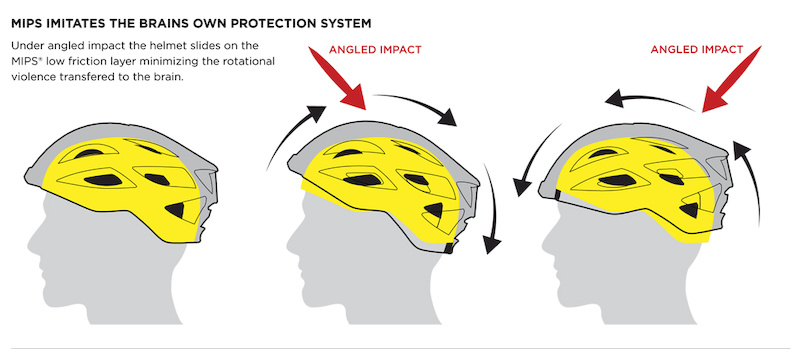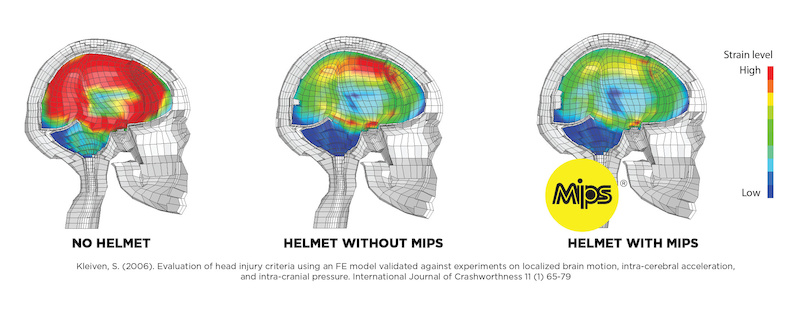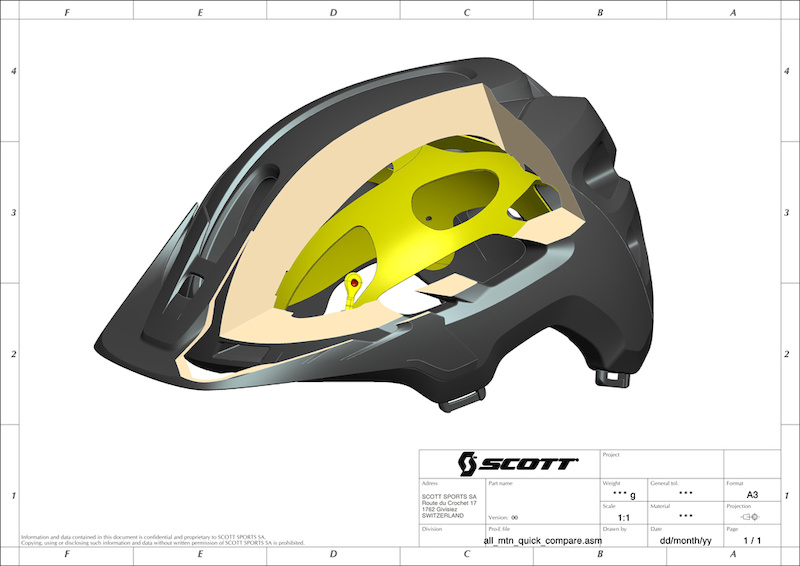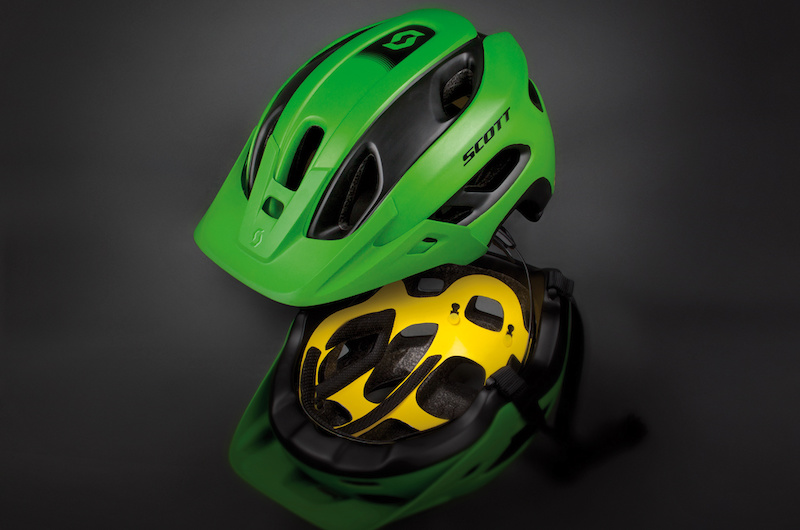To The Point: MIPS
John Thompson is an engineer who, after twelve years of working in mainstream business, left to pursue his dream of working in the bike industry. He moved to Switzerland for the amazing riding on offer, and is now the Bike Helmet Product Manager at Scott. He is part of a passionate international team at Scott focused on creating safe, well-designed helmets. He feels that fashion has dictated too much in the bike helmet market, for too long, leaving customers with a very wide choice of good looking helmets, most of which just about pass the minimum safety requirements. His philosophy is to develop helmets that far exceed safety standards, and to strive to further increase the safety capabilities of Scott helmets by incorporating technologies such as MIPS. After all, as man who describes himself as an aging and avid mountain biker who is not too unfamiliar with the odd dirt sandwich, he is keen to preserve what little horsepower he has left upstairs.
 What is MIPS?
What is MIPS?
MIPS is a Swedish science and technology company focused on improving helmet safety to deal with the type of crashes we experience in the real world. The MIPS Brain Protection System is a helmet safety technology which significantly improves head protection in the event of a crash. When we fall, our head often impacts at an angle. This angular impact creates a rotation in the brain, which has been proven to have significant potential to cause brain damage. With MIPS, the helmet absorbs much of that damaging rotational energy, offering increased protection. MIPS has no effect on the traditional safety mechanism of the helmet, the Expanded Polystyrene (EPS), so the helmets EPS shell is left to do its job of absorbing radial impacts.
 How was it originally discovered?
How was it originally discovered?
MIPS is a result of a Swedish neurosurgeon, Hans von Holst, who while working at the World Health Organization in 1997, felt that traditional helmets did not do enough to protect people and accidents were having devastating consequences for many people. He sought the collaboration of Peter Halldin, researcher at the Royal Institute of Technology in Stockholm, with a view to them trying to develop a technology that could provide more effective protection. The idea was to look more closely at the head's anatomy and physiology, and copy the body's own protection system. Together Peter Halldin and Hans von Holst developed a technology that involved building a cushion or low friction layer into helmets which would provide unique and much improved protection for the brain. Out of this work came the name MIPS, an abbreviation of the functionality of the concept, Multi-directional Impact Protection System.
 What does it look like inside a helmet?
What does it look like inside a helmet?
It is hard to see the MIPS Brain Protection System from the outside of the helmet, but it is easily visible when looking at the inside, It is a bright yellow layer covering most of the inside of the shell, while also featuring corresponding vents to ensure the ventilating properties of the helmet are preserved.
 How does it work?
How does it work?
When the human head is subjected to an angled impact, the brain slides along a membrane on the inner surface of the skull. This freedom to slide reduces the rotational forces transmitted to the brain. MIPS mimics this system by introducing a low friction layer between the head and the helmet. In experimental and numerical tests this low friction layer has shown dramatic reductions in rotational forces transmitted to the brain under angled impacts.
 Do you see MIPS in other types of helmets?
Do you see MIPS in other types of helmets?
We have incorporated MIPS into both mountain bike and city bike helmets. The reason we have done this is not because MIPS is better suited to these applications. It is purely due to the fact that we felt that these type of riders are more receptive to the message of increased safety, and therefor would be more willing to pay the additional cost for a MIPS equipped helmet. We believe in the technology, and feel it has a place in all helmet types. Due to this we have developed a strong partnership with MIPS to ensure the integration of their technology works seamlessly in all of our helmets, and all of the key qualities our customers expect are preserved. The big challenge is to offer MIPS in models where the customers will value the benefits enough to spend the extra amount (typically a €30 upcharge over an equivalent non MIPS equipped helmet). We are committed to continue to release new models with MIPS in the coming years.
www.mipshelmet.com
www.scott-sports.com
 What is MIPS?
What is MIPS?MIPS is a Swedish science and technology company focused on improving helmet safety to deal with the type of crashes we experience in the real world. The MIPS Brain Protection System is a helmet safety technology which significantly improves head protection in the event of a crash. When we fall, our head often impacts at an angle. This angular impact creates a rotation in the brain, which has been proven to have significant potential to cause brain damage. With MIPS, the helmet absorbs much of that damaging rotational energy, offering increased protection. MIPS has no effect on the traditional safety mechanism of the helmet, the Expanded Polystyrene (EPS), so the helmets EPS shell is left to do its job of absorbing radial impacts.
 How was it originally discovered?
How was it originally discovered?MIPS is a result of a Swedish neurosurgeon, Hans von Holst, who while working at the World Health Organization in 1997, felt that traditional helmets did not do enough to protect people and accidents were having devastating consequences for many people. He sought the collaboration of Peter Halldin, researcher at the Royal Institute of Technology in Stockholm, with a view to them trying to develop a technology that could provide more effective protection. The idea was to look more closely at the head's anatomy and physiology, and copy the body's own protection system. Together Peter Halldin and Hans von Holst developed a technology that involved building a cushion or low friction layer into helmets which would provide unique and much improved protection for the brain. Out of this work came the name MIPS, an abbreviation of the functionality of the concept, Multi-directional Impact Protection System.
 What does it look like inside a helmet?
What does it look like inside a helmet?It is hard to see the MIPS Brain Protection System from the outside of the helmet, but it is easily visible when looking at the inside, It is a bright yellow layer covering most of the inside of the shell, while also featuring corresponding vents to ensure the ventilating properties of the helmet are preserved.
 How does it work?
How does it work?When the human head is subjected to an angled impact, the brain slides along a membrane on the inner surface of the skull. This freedom to slide reduces the rotational forces transmitted to the brain. MIPS mimics this system by introducing a low friction layer between the head and the helmet. In experimental and numerical tests this low friction layer has shown dramatic reductions in rotational forces transmitted to the brain under angled impacts.
 Do you see MIPS in other types of helmets?
Do you see MIPS in other types of helmets?We have incorporated MIPS into both mountain bike and city bike helmets. The reason we have done this is not because MIPS is better suited to these applications. It is purely due to the fact that we felt that these type of riders are more receptive to the message of increased safety, and therefor would be more willing to pay the additional cost for a MIPS equipped helmet. We believe in the technology, and feel it has a place in all helmet types. Due to this we have developed a strong partnership with MIPS to ensure the integration of their technology works seamlessly in all of our helmets, and all of the key qualities our customers expect are preserved. The big challenge is to offer MIPS in models where the customers will value the benefits enough to spend the extra amount (typically a €30 upcharge over an equivalent non MIPS equipped helmet). We are committed to continue to release new models with MIPS in the coming years.
www.mipshelmet.com
www.scott-sports.com
Author Info:
Must Read This Week
Sign Up for the Pinkbike Newsletter - All the Biggest, Most Interesting Stories in your Inbox
PB Newsletter Signup






 Member since Oct 29, 2006
Member since Oct 29, 2006
Thanks to the above producers for putting safety and function before aesthetics.
We shouldn't be in a position where people should have to research 'the safest option'; all the options should provide an agreed upon and internationally, legally enforcable level of protection to be approved for sale. As it is, I think a great majority of people will balk at the prospect of paying over $50 for a helmet, making the assumption that 'they all do the same thing anyway; it's just down to looks and weight' which is soooo not the case.
Also, I think POC do a full face with MIPS? I might be wrong, but if technology is proven to reduce the risk of injury what is the harm in employing it?
Oh, and there's no way I'm wearing my full face everywhere! :-)
Sorry, but I can't agree with your argument here...
WHAT?! Did you not even look at the pics in the article?!?!?
www.pinkbike.com/photo/10114692
@matthewlikesbikes - but that depends on lots of other factors, like what Cedric said after his crash in VDiS: tracks should be safer by adding additional padding further away from the track and clearing more area from potentially dangerous elements. It is too complicated to boil it down to personal protection. Sure make it best you can, but I say these days it is almost as good as it can be, unless we develop air bags or something. This MIPS idea here is pretty neat, as in theory it redirects the vector of the force acting upon our skulls, the question is how much. I tend not to believe such graphs, as I know how graphic design works for marketing, but it's made by as Swedish guy so I believe it more than most.
Whatever, the most important thing to remember is that: Protective gear REDUCES negative consequences of an accident, it rarely MINIMIZES them and it never ELIMINATES them. In an event of a high speed crash into a hard object, causing sending you to a virtual stop in a matter of miliseconds and centimeters - be it a tree, lip of a jump, burm - you are going to get seriously fkd, regardless of what you are wearing. Kinetic force is a bitch, that's why I do not ride downhill bikes. Overanalizing of would have could have should have like piercing force is pointless. Fate is coming that I know...
You are wrong about this. There are half-lids that are hardshell and full-faces that are in-mold so they are not exclusive to a certain helmet style. There are also many half-lids that have dual-density designs to help deal with the different forces from an impact. Hardshell helmets do not necessarily provide more safety than in-mold, their uses are situational with hardshells offering more protection against penetration (although POC uses an aramid layer in their in-mold which is *supposed* to offer similar protection) but in-molds offering better absorption.
"Sure make it best you can, but I say these days it is almost as good as it can be, unless we develop air bags or something."
Materials will improve, our understanding of injuries will improve and as a result our protective equipment should improve. I do not think we are anywhere near the limit of what we can do in terms of personal protective equipment.
My problem with these MIPS helmets is that it is only available on high-end helmets so it is not just a $100 price jump for MIPS but a $300 price jump for MIPS, carbon fiber, epp, etc.
Penetration... roadie/xc lids are kind of out of equation here, and I'd say most "Enduro" helmets as well. A branch has a high chance of finding it's way into Trabecs vent. In molds are off course better because they will crack easier, absorb some energy this way and then by deforming further due to the crack, allow brain for a bit more travel, thus take some edge off the impact. Hardshell piss pots are good for street riding due to particularly high risk of hitting hard and sharpish objects that might crack the helmet so severly that they could separate in-mold and hit the skull directly. Then they are excellent canvas for graphics related to "cool stuff of any kind" thus many other "genres" are using them, even though they are doing worse job that in-moldish helmets. they are much better to make a statement and express your own personality than any other helmet. Form takes over function big time.
When it comes to life threatening crashes I do not think much more can be done with "classic" designs, because not much more tech, if any, is used in best car and moto helmets. Air bags or it's nearly over. Carbon fibre in helmets is nothing more but a price booster.
About POC - it is a company that uses "high tech" that is rich in law of diminishing returns, as their main mean of "establishing a niche" or being "unique". That comes at the cost of high price while getting little if any actual gains - I will never buy anything from them. It is ruled by same mentality as another snobbish Swedish brand: Peak Performance. If I had POC money I'd go for D3 and Dainese for the rest of protection without a blink of an eye. But I don't, so I go D2 and 661.
BTW one drawback is that any helmet with MIPS is going to be less suitable to carry a helmet cam. Any POV camera on the top of a helmet will make it inevitably somewhat top-heavy and, in my experience, MIPS seems to contribute to a little extra wobble.
He says -
"I worked 16 yrs in the composite industry and believe I know sufficient to judge that the helmet is still usable largely due to that impact-absorption layer, and its tendency to not lose strength after minor deformations, whereas I have binned other helmets after far less impact."
(in case you couldn't guess, yes I was joking)
www.bicycling.com/senseless/index.html
The video they show is in a controlled lab environment. They used a dummy head to do the tests. What about the rest of the body and how that will effect your crash? Does the dummy head weigh the same as an average human head or the average weight of the entire body? Did they do the test from multiple different angles to account for different ways of crashing and hitting your head?
mipshelmet.com/how-it-works/test_results
there are 5 videos at the bottom that all show a similar crash angle.
I would like to assume these variables(and others) were taken into account. Has anyone been able to find out more about the testing procedures MIPS does on their helmet system? Should I just look in the official governmental testing procedures to gain more insight?
I have similiar liner in my old speleo helmet (manufactured by Petzl).
And it works great.
What can I say, I'm a broke ass university student.
Besides CPSC helmet certification is still legitimate, even if it might be arguably less safe than the MIPS they are advertising.
Government is notoriously slow to change.
www.bicycling.com/senseless/index.html
Here's the bottom line on why change is so slow from that article:
"I think bringing in new standards is always tough for a manufacturer because we have moulds and tools in place and that tooling is hundreds of thousands of dollars," he says.
"To enforce a new standard for Canada would mean a lot of retooling, which would be a huge financial burden and time constraint on all manufacturers."
A properly fitted and adjusted helmet should not slide on the head, regardless of intended purpose.... Although, 'skate' or 'dirtjump' helmets are usually worse due to the lack of adjustment, and often poor fit.
My point was so maybe so they should be doing and I thought it was a bad thing while it is the opposite?
Meant nothing wrong but well Fkng neg-prop commitee chimed in - heel my angry puppies heeele! Whoops now I meant...